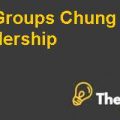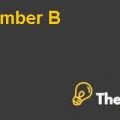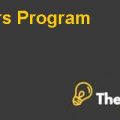
Activity-Based Management at W.S Industries (B)
1. What are the difficulties faced by W.S Industries in competing with competitors and the strategies adopted by management in order to achieve long term success?
The company faced several market pressures on price and the customers believed that the product offered by the company was bulky, which ultimately threatened the long term profit of the company. The company decided to revise the selling price of its product and concluded to adopt a target cost approach in order to face the latest crises.
Target costing approach is totally different from the traditional cost based approach where the entity first calculated the cost and assigned a desired profit margin. In target costing approach, a desired selling price will be set for the product which the customer is willing to pay; later on a desired profit margin will be deducted from the selling price which will leave the targeted cost, such cost will be compared with the actual cost and it will result in a cost gap. After that, the company will take initial steps in order to avoid or eliminate such cost gap.
The customers of W.S Industries were willing to pay a desired selling price of Rs. 180 and the company considered to enjoy a profit margin of Rs. 15 on such product. Further, the company also expected that the admin and selling cost would comprise of Rs. 30 which left Rs. 135 as the target cost. The company further split the cost in 60:40 and separated Rs. 104 for material and Rs. 70 for processing.
As identified in Exhibit 10b, the actual cost for the material available in the market was Rs. 104.04 whereas; the targeted cost of the material was only Rs. 81 which left the cost gap of Rs. 23.04 in material cost. The company would be required to adopt appropriate steps in order to reduce costs substantially. So, in order to eliminate cost gap, the company split the cost between value adding and non-value adding activities. The company would now focus of activities which were most valuable to the customers so the company would not have to compromise in such things whereas; the cost on non-value adding activities could be compromised in order to reduce the cost of the product.
The most valuable items to the customers are functionality, reliability; ease of handling and visual quality, so the organization must consider such items with great concern. Further, the company adopts a practice to allocate a percentage of total value that subjectively contributed to the customer. The targeted cost of the product was Rs. 165 whereas the new cost calculated for the product remained Rs. 180 that might not be accepted by the company, so the organization shall adopt continuous improvement strategies in order to reduce cost substantially and enjoy profits in the long run.
- 2. What are the strategies available to the company to reduce its cost substantially?
The company can adopt a Kaizen costing approach in order to reduce cost and improve continuously. Kaizen costing is a continuous cost reduction approach after a product design has been completed. The cost minimizing strategies can be adopted by effectively managing the waste, implementing less costly re-designs of product and purchasing raw material at relatively reduced price.
The Kaizen costing is a continuous improvement activity in manufacturing phase which will reduce cost in the full cycle of design-development cycle. Kaizen costing is same as budgetary control but is outside the scope of cost accounting system, which usually focuses on cost reduction targets and achieves the company’s objectives through continuous improvements.
It is based on two major components, first one is maintenance and the second one is improvement. Maintenance is basically related with maintaining the current standards of technological and operational standards, so in order to facilitate this strategy the company sets proper SOPs which are required for everyone to follow. Further, improvements are encouraged to improve the current standards which can be achieved through innovations and as a result of co-ordinated continuous efforts by all employees.
W.S Industries can implement Kaizen costing in order to achieve cost, efficiency and quality. Each department is held responsible for achieving Kaizen costs in their departments i.e. managers will be required to encourage labour in order to execute low labour hour which will ultimately reduce labour cost. Further, each and every single employee will be encouraged to maintain quality which will reduce the cost of rectification........................................
This is just a sample partial case solution. Please place the order on the website to order your own originally done case solution.













